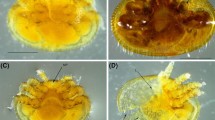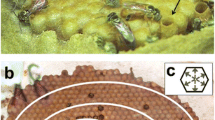The removal of small hive beetle [=SHB] eggs and larvae was studied in queenright and recently queenless Cape honeybee, Apis mellifera capensis, colonies over a range of phenotypes. The overall removal efficiency was not influenced by phenotypes or queenstate, because all introduced eggs and larvae were removed within 24 hours. Queenless colonies removed them merely slower than queenright ones. The latter ones rejected up to 300 larvae within one hour. However, colonies undergoing preparation for absconding did not completely remove SHB offspring, suggesting that removal efficiency was reduced. Since even small and recently queenless colonies effectively removed immature SHB, and no differences in the overall efficiency was found compared to A. m. scutellata we conclude that this defense behavior is well developed in African honeybees.


Similar content being viewed by others
REFERENCES
Eischen, F. A., Rinderer, T. E., and Dietz, A. (1986). Nocturnal defensive responses of Africanized and European honey bees to the greater wax moth (Galleria mellonella L.). Anim. Behav. 34: 1070–1077.
Ellis, J. D., Holland, A. J., Hepburn, H. R., Neumann, P., and Elzen, P. J. (2003a). Cape (Apis mellifera capensis) and European (Apis mellifera) honey bee guard age and duration of guarding small hive beetles (Aethina tumida). J. Apic. Res. 42: 32–34.
Ellis, J. D., Richards, C. S., Hepburn, H. R., and Elzen, P. J. (2003b). Oviposition by small hive beetles elicits hygienic responses from Cape honeybees. Naturwissenschaften 90: 532–535.
Ellis, J. D., Delaplane, K. S., Richards, C. S., Hepburn, R., Berry, J. A., and Elzen, P. J. (2004). Hygienic behaviour of Cape and European Apis mellifera (Hymenoptera: Apidae) toward Aethina tumida (Coleoptera: Nitidulidae) eggs oviposited in sealed brood cells. Ann. Entomol. Soc. Am. 97: 860–864.
Gerig, L. (1983). Lehrgang zur Erfassung der Volksstärke. Schweiz. Bienen-Zeitung 106: 199–204.
Hepburn, H. R., and Radloff, S. E. (1998). Honeybees of Africa. Springer Verlag, Berlin, Heidelberg, New York.
Imdorf, A., Bühlmann, G., Gerig, L., Kilchenmann, V. and Wille, H. (1987). Überprüfung der Schätzmethode zur Ermittlung der Brutfläche und Anzahl Arbeiterinnen in freifliegenden Bienenvölkern. Apidologie 18: 137–146.
Lundie, A. E. (1940). The small hive beetle Aethina tumida. Science Bulletin 220, Dep. Agr. Forestry, Government Printer, Pretoria, South Africa.
Lundie, A. E. (1952). The principal diseases and enemies of honey bees. S. Afr. Bee J. 27: 13–15.
Mürrle, T., and Neumann, P. (2004). Mass production of small hive beetles (Aethina tumida Murray, Coleoptera: Nitidulidae). J. Apic. Res. 43: 144–145.
Neumann, P., and Elzen, P. J. (2004). The biology of the small hive beetle (Aethina tumida Murray, Coleoptera: Nitidulidae): Gaps in our knowledge of an invasive species. Apidologie 35: 229–247.
Neumann, P., and Härtel, S. (2004). Removal of small hive beetle (Aethina tumida) eggs and larvae by African honeybee colonies (Apis mellifera scutellata). Apidologie 35: 31–36.
Neumann, P., Pirk, C. W. W., Hepburn, H. R., Solbrig, A. J., Ratnieks, F. L. W., Elzen, P. J., and Baxter, J. R. (2001) Social encapsulation of beetle parasites by Cape honeybee colonies (Apis mellifera capensis Esch.). Naturwissenschaften 88: 214–216.
Punchihewa, R. W. K., Koeniger, N., and Howpage, D. (1990) Absconding behaviour of Apis cerana in Sri Lanka. In Proceedings of the 11th International Congress of IUSSI, India, pp. 106–107.
Ritter, W. (2004). Beutenkäfer in Portugal. Deutsches Bienen J. 12(12): 14.
Schmolke, M. D. (1974). A study of Aethina tumida: the small hive beetle. Project Report, University of Rhodesia.
Somerville, D. (2003). Study of the small hive beetle in the USA. Report for the Rural Industries Research and Development Corporation, NSW Agriculture, RIRDC Publication No 03/050.
Spiewok, S., Neumann, P., and Hepburn, H. R. (2006). Preparation for disturbance-induced absconding of Cape honeybee colonies (Apis mellifera capensis Esch.). Ins. Soc. 53: 27–31.
Swart, J. D., Johannsmeier, M. F., Tribe, G. D., and Kryger, P. (2001). Diseases and pests of honeybees. In: Johannsmeier, M. F. (ed.) Beekeeping in South Africa, 3rd edition, revised, Plant Protection Research Institute Handbook No. 14, Agricultural Research Council of South Africa, Pretoria, South Africa, pp. 198–222.
ACKNOWLEDGMENTS
We are grateful to U Epperlein for technical assistance and M Kramer (USDA Beltsville) for statistical advice. Financial support was granted by a Visiting Professorship at Rhodes University and an Emmy Noether fellowship of the DFG [PN].
Author information
Authors and Affiliations
Corresponding author
Rights and permissions
About this article
Cite this article
Spiewok, S., Neumann, P. The Impact of Recent Queenloss and Colony Pheno-type on the Removal of Small Hive Beetle (Aethina tumida Murray) Eggs and Larvae by African Honeybee Colonies (Apis mellifera capensis Esch.). J Insect Behav 19, 601–611 (2006). https://doi.org/10.1007/s10905-006-9046-z
Published:
Issue Date:
DOI: https://doi.org/10.1007/s10905-006-9046-z




